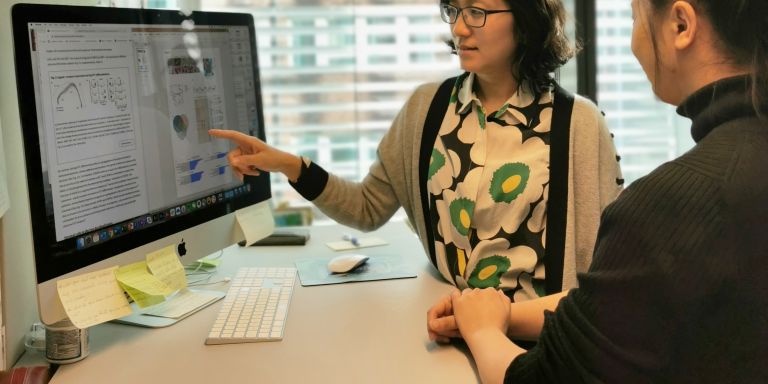
Qiaolin Deng
PhD in Medical Science
Wallenberg Academy Fellow, prolongation grant 2020
Institution:
Karolinska Institutet
Research field:
Developmental biology and reproductive medicine


Wallenberg Academy Fellow, prolongation grant 2020
Institution:
Karolinska Institutet
Research field:
Developmental biology and reproductive medicine
Mammalian gametes, male sperm and female egg cells, differ from the body’s cells in that they contain only half as much DNA. They are formed by a special kind of division of germ cells in the gonads. The germ cells have an unusual history. Their foundations are laid in the early embryonic stage, when the cells that are to become germ cells have to be separated from body cells, so that they are not disturbed by processes that the body cells go through.
“Mammals have an ingenious way of protecting their germ cells. They are initially settled outside the embryo itself. From there they migrate, for a limited time and following a highly specific route, through the embryo to the place where the gonads form,” explains Qiaolin Deng, Wallenberg Academy Fellow at Karolinska Institutet.
Most of her research is conducted on mice, which have a gestation period of twenty days. It takes two to three days for the germ cells to migrate to their destination. Many of them do not make it. Deng and her colleagues believe that the journey through the embryo acts as an early quality control. One purpose of the process is the correct removal of some of the “memory molecules”, known as epigenetic modifications, attached to the DNA and proteins of the cell.
“At the very earliest embryonic stage all cells are the same, but in the germ cells a number of genetic and epigenetic reprogramming events take place. We’re really interested in studying how these processes are coordinated as the cells migrate to the gonads while also dividing, thereby multitasking along the way.”
Fewer than half reach their goal before the gonad closes up. Those left outside are eliminated – mostly. The mechanisms of this process make up one of Deng’s central research topics. This is because cells that are not destroyed and remain in the embryo can cause certain types of cancer in children. A detailed understanding of the process and why it sometimes malfunctions may provide new knowledge about these and other forms of cancer.
“How has the body designed this strict surveillance system, which eliminates germ cells that remain in the wrong place? Findings may help us to understand why cancer spreads, when the body fails to identify and destroy defective cells.”
Another disease Deng is studying is polycystic ovary syndrome (PCOS), a common reproductive and endocrine disorder. Her research in mice suggests that there are factors in the uterine environment of mothers with PCOS that are unfavorable for embryo and germ cell development. They also increase the risk for the children and even grandchildren to develop PCOS-like disorders. She is now planning to further explore the underlying mechanisms.
“Being chosen as a Wallenberg Academy Fellow is like being welcomed into the best family. The grant is not just about funding; it means a lot for my personal development. It’s the best career path in research that I can imagine.”
Deng is trying multiple techniques to monitor individual cells in mouse embryos. One allows her to activate genes so that the germ cells produce colored and fluorescent proteins in different stages of their development, which enables her to study their migration and propagation. Another method consists in infecting the cells with harmless virus particles containing a “bar code”. This enables the researchers to identify which cells finish the journey, and which divide the most times along the way.
“We’re trying to see whether there are differences right from the outset that reveal which cells will make it to the gonad, and which are best at dividing. I think selection takes place here, but no one has studied it on a single-cell level before.”
More knowledge about the genes and signal substances that regulate germ cell maturation and migration not only provides important clues about diseases and therapies; it may also form the basis for more and better research studies. At present it is only possible to culture and study germ cells in their very early stages. A deeper insight into migration and maturation might make it possible for Deng to find efficient ways of culturing germ cells in the laboratory through all stages of their development. This would be an important breakthrough.
When Deng was studying medicine back home in Shanghai, she did not think she would choose research as her future career. When she first arrived in Stockholm to visit her boyfriend, who was then at Karolinska Institutet, her eyes were opened to the advanced medical research and the training opportunities available there.
“When I arrived at Karolinska I was amazed by the scientific environment and learning activities. I still remember how I spent most of the day in the library and read books that I had never seen. Nowadays Chinese and Swedish laboratories are more alike, but at that time it was like stepping into another world. I started a PhD on developmental biology, and later on was very fortunate to catch an early tide of single-cell technology. I’m very grateful for the Wallenberg Academy Fellow grant. It stands for the highest level of research and is very competitive. My first application was not successful and I didn’t dare to get my hopes up for this second try, so it is like a dream come true. Resilience is the most important quality of a scientist!”
Text Lisa Kirsebom
Translation Maxwell Arding
Photo Sanjiv Risal, Qing Luo